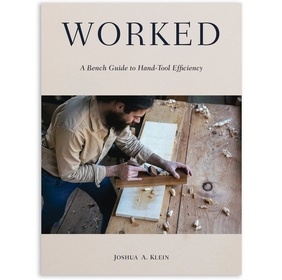Ouvrage
Contenu
Résumé
There is a gap in most woodworking instruction. Somewhere in between tool descriptions (what they are and what they do) and step-by-step project tutorials, we are missing something vital. We may understand what a backsaw is, or what a hatchet is capable of… but how do we actually do it? How do we engage the wood with these tools? And how do we confidently proceed through a project from start to finish with a clear understanding of efficient workflow?
In Worked: A Bench Guide to Hand-Tool Efficiency, author Joshua A. Klein introduces us to the steps between the steps, demonstrating the mindset of the period woodworker as a project unfolds. He demonstrates the most efficient body postures to generate maximum power for ripping a board, how crosscutting with a sawbench utilizes the combined forces of the cutting sawteeth and body weight to firmly hold the lumber in place, and why sitting on your workpiece might be the best way to secure it. Eschewing locked-down, difficult-to-adjust workholding methods, Klein shows us how simple bench hooks, pegs, body weight, and human-powered vises like the shaving horse can be best utilized for speed and enjoyment.
Klein walks us through a variety of methods of stock preparation, taking raw billets of green wood and rough-cut lumber down to the dimensions we need. Through tasks such as riving with a froe, hewing with a hatchet, heavy planing, flattening twisted boards, and breaking down lumber with rip and crosscut saws, we will explore the many facets of efficient workflow and process. And like any Bench Guide-series book, this volume features a special lay-flat binding to stay open on your bench, hundreds of beautifully clear photographs, and detailed commentary. It is designed to find a home in your workshop.
In Worked: A Bench Guide to Hand-Tool Efficiency, author Joshua A. Klein introduces us to the steps between the steps, demonstrating the mindset of the period woodworker as a project unfolds. He demonstrates the most efficient body postures to generate maximum power for ripping a board, how crosscutting with a sawbench utilizes the combined forces of the cutting sawteeth and body weight to firmly hold the lumber in place, and why sitting on your workpiece might be the best way to secure it. Eschewing locked-down, difficult-to-adjust workholding methods, Klein shows us how simple bench hooks, pegs, body weight, and human-powered vises like the shaving horse can be best utilized for speed and enjoyment.
Klein walks us through a variety of methods of stock preparation, taking raw billets of green wood and rough-cut lumber down to the dimensions we need. Through tasks such as riving with a froe, hewing with a hatchet, heavy planing, flattening twisted boards, and breaking down lumber with rip and crosscut saws, we will explore the many facets of efficient workflow and process. And like any Bench Guide-series book, this volume features a special lay-flat binding to stay open on your bench, hundreds of beautifully clear photographs, and detailed commentary. It is designed to find a home in your workshop.
Détails
Cette fiche est complétée et contrôlée collaborativement par la communauté. Si vous détectez des erreurs ou des manques, apportez vos propositions !
Critiques
Ce livre ne possède pour l'instant aucune critique de lecteur.
Soyez le premier à ajouter la votre !
Soyez le premier à ajouter la votre !
Connectez-vous pour ajouter votre critique.
Vous n'êtes pas autorisé à indiquer votre accord ou désaccord vos propres contributions.
L'adresse e-mail associée à votre compte doit être confirmée avant de pouvoir indiquer votre accord ou désaccord.
Chargement...
Chargement...
Publications associées
0
collection



Discussions